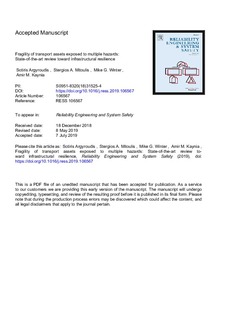Fragility of transport assets exposed to multiple hazards: State-of-the-art review toward infrastructural resilience
Journal article, Peer reviewed
Date
2019Metadata
Show full item recordCollections
- NGI articles [1037]
Original version
10.1016/j.ress.2019.106567Abstract
Vulnerability is a fundamental component of risk and its understanding is important for characterising the reliability of infrastructure assets and systems and for mitigating risks. The vulnerability analysis of infrastructure exposed to natural hazards has become a key area of research due to the critical role that infrastructure plays for society and this topic has been the subject of significant advances from new data and insights following recent disasters. Transport systems, in particular, are highly vulnerable to natural hazards, and the physical damage of transport assets may cause significant disruption and socioeconomic impact. More importantly, infrastructure assets comprise Systems of Assets (SoA), i.e. a combination of interdependent assets exposed not to one, but to multiple hazards, depending on the environment within which these reside. Thus, it is of paramount importance for their reliability and safety to enable fragility analysis of SoA subjected to a sequence of hazards. In this context, and after understanding the absence of a relevant study, the aim of this paper is to review the recent advances on fragility assessment of critical transport infrastructure subject to diverse geotechnical and climatic hazards. The effects of these hazards on the main transport assets are summarised and common damage modes are described. Frequently in practice, individual fragility functions for each transport asset are employed as part of a quantitative risk analysis (QRA) of the infrastructure. A comprehensive review of the available fragility functions is provided for different hazards. Engineering advances in the development of numerical fragility functions for individual assets are discussed including soil-structure interaction, deterioration, and multiple hazard effects. The concept of SoA in diverse ecosystems is introduced, where infrastructure is classified based on (i) the road capacity and speed limits and (ii) the geomorphological and topographical conditions. A methodological framework for the development of numerical fragility functions of SoA under multiple hazards is proposed and demonstrated. The paper concludes by detailing the opportunities for future developments in the fragility analysis of transport SoA under multiple hazards, which is of paramount importance in decision-making processes around adaptation, mitigation, and recovery planning in respect of geotechnical and climatic hazards. Fragility of transport assets exposed to multiple hazards: State-of-the-art review toward infrastructural resilience
